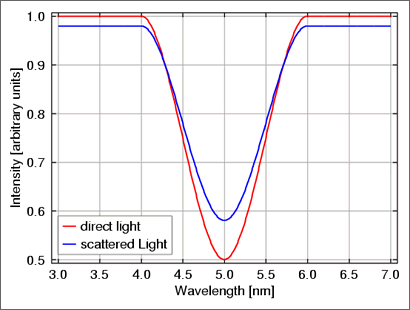As a result of Raman scattering, a proportion of incident photons have their wavelengths changed by a few nm. This causes an intensity loss at their incident wavelengths but a gain at the neighbouring wavelengths to which they are distributed.

Fig 3.2.2.1.1: Filling in of a Fraunhofer absorption line as a result of the Ring effect over a wavelength segment of 4 nm.
Image: AT2-ELS
- Because at a given wavelength the loss of photons due to Raman scattering is proportional to the radiation intensity at that wavelength, more photons are lost at high intensity wavelengths than at low intensity wavelengths. Thus the ranges 3..4 nm and 6..7 nm in the curve in figure 3.2.2.1.1 show high intensity radiation being reduced in intensity after experiencing Raman scattering. In contrast, the low intensity range at the base of the absorption line at 3.5..5.5 nm experiences a smaller loss as a result of Raman scattering.
- The number of photons that are gained at a particular wavelength depends on the intensity of radiation at the original wavelength. Thus high intensity ranges such as 3..4 nm and 6..7 nm in the curve in figure 3.2.2.1.1 shift proportionately more photons into lower intensity ranges such as 4.5..5.5 nm than vice versa. Thus the low intensity range gains proportionately more photons from Raman scattering than do the high intensity ranges. This gain exceeds the loss that also takes place by Raman scattering in the low intensity range.
As can be clearly seen in the figure, the net result of these two effects of Raman scattering is to reduce the depth of narrow absorption lines in the spectrum, in particular that of Fraunhofer lines. In sum, where Δλ represents the wavelength change due to Raman scattering, the loss by Raman scattering at wavelength λ is proportional to intensity, the gain by Raman scattering at wavelengths λ±Δλ is also proportional to the intensity at λ.
This 'filling in' effect on Fraunhofer lines in scattered light was first observed by astronomers and is named the Ring effect after its discoverer.
In the DOAS evaluation, the cancellation of Fraunhofer lines, which is achieved by taking the ratio I / I0, is no longer perfect if one of the spectra is affected by Raman scattered photons. As a result a strongly structured residual appears which mirrors the distribution of Fraunhofer lines.